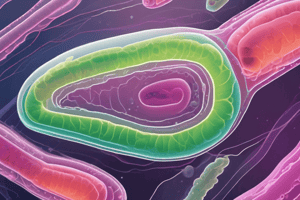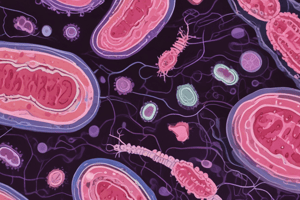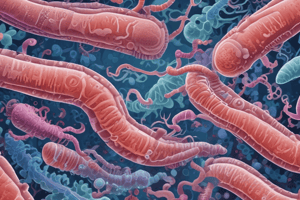Podcast
Questions and Answers
ENTEROINVASIVE E COLI (EIEC) Seen in children younger than 5 years linked to contaminated food or water. There is a lower incidence of person-to-person transmission of EIEC. Humans are the only known reservoir. Causes bloody diarrhea *EIEC closely resemble Shigella ______
ENTEROINVASIVE E COLI (EIEC) Seen in children younger than 5 years linked to contaminated food or water. There is a lower incidence of person-to-person transmission of EIEC. Humans are the only known reservoir. Causes bloody diarrhea *EIEC closely resemble Shigella ______
bacteria
ENTEROAGGREGATIVE E COLI (EAEC) Is associated with (more than 14 days) watery diarrhea, occasionally with blood and mucus. First recognized in infants and children. The EAEC pili (aggregative adherence fimbriae [AAF]) mediate tight adherence to the intestinal mucosa, but the A/E lesions of the EPEC and EHEC are not present. The tight adherence of EAEC provided a particularly effective mechanism for delivery of Stx to the intestinal ______
ENTEROAGGREGATIVE E COLI (EAEC) Is associated with (more than 14 days) watery diarrhea, occasionally with blood and mucus. First recognized in infants and children. The EAEC pili (aggregative adherence fimbriae [AAF]) mediate tight adherence to the intestinal mucosa, but the A/E lesions of the EPEC and EHEC are not present. The tight adherence of EAEC provided a particularly effective mechanism for delivery of Stx to the intestinal ______
mucosa
ENTEROAGGREGATIVE E COLI (EAEC) Is associated with (more than 14 days) watery diarrhea, occasionally with blood and mucus. First recognized in infants and children. The EAEC pili (aggregative adherence fimbriae [AAF]) mediate tight adherence to the intestinal ______, but the A/E lesions of the EPEC and EHEC are not present. The tight adherence of EAEC provided a particularly effective mechanism for delivery of Stx to the intestinal mucosa
ENTEROAGGREGATIVE E COLI (EAEC) Is associated with (more than 14 days) watery diarrhea, occasionally with blood and mucus. First recognized in infants and children. The EAEC pili (aggregative adherence fimbriae [AAF]) mediate tight adherence to the intestinal ______, but the A/E lesions of the EPEC and EHEC are not present. The tight adherence of EAEC provided a particularly effective mechanism for delivery of Stx to the intestinal mucosa
mucosa
ENTEROINVASIVE E COLI (EIEC) Seen in children younger than 5 years linked to contaminated food or water. There is a lower incidence of person-to-person transmission of EIEC. Humans are the only known reservoir. Causes bloody diarrhea *EIEC closely resemble ______
ENTEROINVASIVE E COLI (EIEC) Seen in children younger than 5 years linked to contaminated food or water. There is a lower incidence of person-to-person transmission of EIEC. Humans are the only known reservoir. Causes bloody diarrhea *EIEC closely resemble ______
ENTEROINVASIVE E COLI (EIEC) causes watery diarrhea.
ENTEROINVASIVE E COLI (EIEC) causes watery diarrhea.
ENTEROINVASIVE E COLI (EIEC) is commonly transmitted from person to person.
ENTEROINVASIVE E COLI (EIEC) is commonly transmitted from person to person.
The EAEC pili mediate tight adherence to the intestinal mucosa.
The EAEC pili mediate tight adherence to the intestinal mucosa.
ENTEROAGGREGATIVE E COLI (EAEC) is first recognized in adults.
ENTEROAGGREGATIVE E COLI (EAEC) is first recognized in adults.




